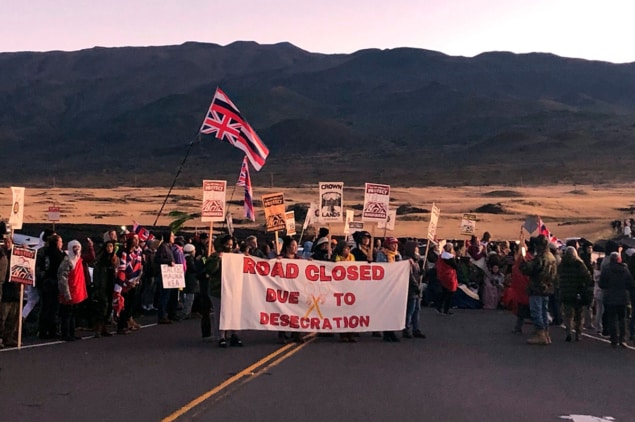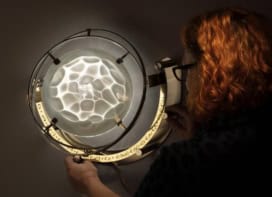As the astronomy community celebrates this year’s Nobel Prize for Physics, Pruthvi Mehta says that the ongoing controversy over the Thirty Meter Telescope continues to stain the field

This year’s Nobel Prize for Physics celebrates a huge achievement in astronomy. Andrea Ghez from the University of California, Los Angeles, and Reinhard Genzel from the Max Planck Institute for Extraterrestrial Physics in Garching, Germany, shared half the prize for providing the first conclusive evidence of a supermassive black hole at the centre of the Milky Way. The other half went to the University of Oxford mathematical physicist Roger Penrose for his theoretical work on the origin of black holes.
Though Ghez and Genzel’s achievements are obviously warranted, one cannot – and should not – ignore the controversies surrounding the observatories that were so critical to the discovery. Every article I read about this year’s Nobel prize failed to even hint at the debate surrounding the observatories that were key to the work. Genzel used telescopes in Chile, while Ghez worked on the W M Keck observatory on Maunakea – the most sacred place in the Hawaiian Islands.
Maunakea is short for Mauna a Wakea or “Mountain of Wakea” – Wakea being one of the progenitors of the Hawaiian people. It is the home of divine deities of the Hawaiian people and is the burial ground and embodiment of ancestors, including high-ranking chiefs and priests. To many Hawaiians and Hawaiian cultural organizations, the observatories on Maunakea are sacrilegious, destroying Hawaiian family shrines.
Currently the island is home to 13 observatories, the existence of which is due to, and benefits from, the colonization of Hawaii. In 1898 the US annexed the Hawaiian Islands and made them into its territory. The Republic of Hawaii was created by Western settlers who led a rebellion against the queen regent of the Hawaiian Kingdom. The annexation of these lands was widely opposed in Hawaii and many US scholars still debate whether these lands were taken in proper accordance with the US constitution.
Due to these legal complexities, the lands are referred to as “ceded lands”, unlawfully and violently taken, and it is this ceded land that Maunakea is part of. “Hawaii was never acquired lawfully,” said Kealoha Pisciotta, a former employee of the Mauna Kea Observatories, in an article in the Atlantic in 2015. As leader of the Mauna Kea Anaina Hou – a group dedicated to protecting Maunakea from further development – Pisciotta added “No money can buy sacredness.”
Looking back at the history of the Maunakea observatories, however, apparently money can and has bought sacredness. In the 1970s John Jeffries, a physicist at the University of Hawaii, discussed at town hall meetings the economic advantage of further development on Maunakea to convince those who were opposed. Such developments were eventually allowed, even though the land is supposedly protected by the US Historical Preservation Act due to its significance to Hawaiian culture.
Taking a moral position
We are in a similar position today regarding the proposed Thirty Meter Telescope (TMT), which, if built, would be the largest visible-light telescope on Maunakea. For years, it has faced continuing opposition by activists, including Pisciotta. Yet the TMT’s website provides little information about the valid concerns and outrage Native Hawaiian activists feel about building the TMT on Maunakea and fails to mention the mountain’s sacredness. Instead, the legitimate peaceful protests are called “unforeseen challenges” and it includes vague statements about “wanting to better understand the island’s issues as well as the cultural and natural significance of Maunakea”.
There is also no mention of the videos that show astronomers failing to stop state violence at peaceful protests, or show Hawaiian elders being arrested. There is no denouncement or admonishment of Western astronomers who have made racist characterizations of Hawaiians who oppose the development. Retired astronomer Sandra Faber at the University of California, Santa Cruz, for example, wrote in an e-mail to colleagues in 2015 that the TMT has been “attacked by a horde of native Hawaiians who are lying about the impact of the project on the mountain”.
Astrophysicists – and indeed the wider physics community – must ask themselves if Western science should continue to trample over the ideas and beliefs of native people at the insistence that it is for the “greater good”. Why, after centuries of struggle, can Indigenous people still not have a say over what happens to their own home? Why is the complete refusal to respect the millennia-old sacred beliefs of a nation in favour of an experiment somehow an accepted moral position to take? Thirty Meter Telescope forges ahead with Canary Islands site
Telescopes have already been built on the graves of Hawaii’s beloved ancestors. These people have been hurt enough. As Steve Lekson, curator of archaeology at the University of Colorado Museum of Natural History, commented to the New York Times in 2014: “Given that the US was founded on two great sins – genocide of Native Americans and slavery of Africans – I think science can afford this act of contrition and reparation.” I agree. If the TMT isn’t built on Maunakea, the physics community will be just fine.
I watched Ghez’s public lecture following the announcement of the Nobel prize unhappy, but not surprised, that the controversy over the TMT was not addressed. Instead, its virtues were extolled: the insistence that Maunakea is the perfect location due to its elevation, that it suffers little light pollution and lacks turbulent air around the peak that can spoil observations.
Enough has been done to harm the beliefs of the people to whom the land belongs. There is already a deep, poisonous vein of systemic racism that runs through many scientific fields – let’s not try to cement it.



